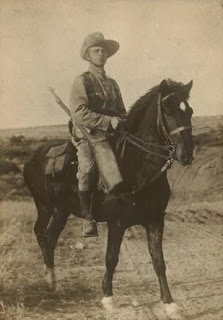 |
| Asser Riarua (2nd from left): Photo courtesy Wecke and Voights Collection |
The elder Riarua had been the supreme military commander and adviser to his half brother, the Herero chief Maharero kaTjamuaha (who died in 1890). After the death of the chief in 1890, Riarua was a rival claimant against Maharero's christian son Samuel Maharero, for the chieftaincy of the Okahandja Herero and other inheritance rights. Traditional leaders backed Riarua, but Samuel Maharero had the backing of the German authorities and the Rhenish missionaries, however, and was ultimately recognized by them as paramount chief of the Herero.
Assa Riarua (b. 1848) was a close friend of Samuel Maharero's who as his veld-cornet or under captain lead his forces against the Nama Kaptein Henrick Witbooi in 1892, and later rallied with him in 1894 when Riarua and his supporters challenged his position as paramount chief. There is a wonderful description in Jan-Bart Gewald's (1999) Herero Heroes of a reenforcing German column approaching its ally Samuel Maharero's hilltop laager, surrounded by its hedge of thorn and with the Imperial German flag flying above, and being met by "Assa Riarua, who, dressed in the uniform of the German Kaiser's French Guard regiment, told them that Samuel would be joining them as soon as he had finished conducting a field church service."
Backed by German firepower and with the assistance of Assa Riarua, Samuel was able to compel the elder Riarua to relinquish all his claims to Maharero kaTjiamuaha's inheritance. Why Assa Riarua chose to support Samuel over his father is a question that deserves further study, though his mission upbringing and the complexities of Herero clan inheritance structures may have been factors. He might also have seen alliance with Samuel as a path to wealth, and indeed he lead Herero forces along side the Germans in 1895 during the boundary dispute with rival eastern Herero and ovambanderu.
Both Assa Riarua and Samuel were heavily indebted to German traders. Assa Riarua continued to have difficulties with German merchants, one of whom later forcibly ejected him from a bakery in Windhoek and beat him bloody in the street. In 1903, Assa Riarua and his followers in Okahandja vocally resisted German encroachment on Herero lands when a proposed native reserve left them with too little territory, unsuitable for grazing, and outside their customary areas of residence. The reserves were finalized despite these objections and the crisis with the German authorities worsened. Neither Samuel nor Assa Riarua nor Governor Leutwein were available to intervene in Okahandja when misunderstandings and tensions boiled over in January, 1904 and open hostilities began.
Assa Riarua continued as one of Samuel's ablest commanders during the war with the Germans, who for their part suspected him of being the mastermind behind the "revolt". He commanded the Herero left wing at Ongandjira, and in the early stages of the war was among the Herero leaders who granted safe passage to the German missionary Eich and a small party of German women and children.
After the battles around Waterberg in August 1904, Assa Riarua was among the Herero who fled into the Omaheke. The captured Herero leader Zacharius Zeraua later told the Germans that by early September, 1904, Assa Riarua was with Samuel and most of the surviving Herero leadership at a waterhole known as Osombo Onjatu on the dry Eiseb River. His fate thereafter is unknown, but his daughter Diana Riarua survived in Botswana and reported that after Samuel's death in 1923, his spirit visited her in Christlike fashion with a message that "mine are those who will do my will."









_Deutsch-S%C3%BCdwestafrika.jpg)





























